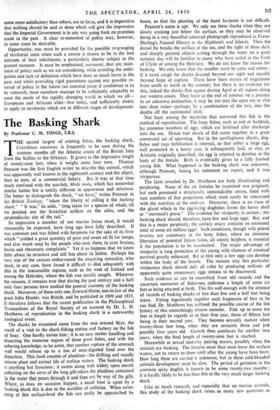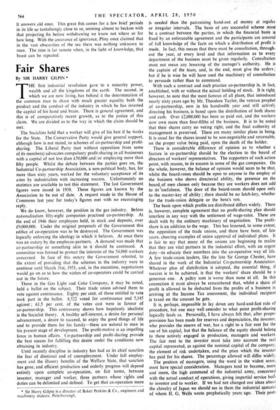The Basking Shark ,
By Professor C. M. YONGE, F.R.S.
THE second largest of existing fishes, the basking shark, Cetorhinus maximus, is frequently to be seen during the
summer months off the Atlantic coasts of the British Isles from the Scillies to the Orkneys. It grows to the impressive length of twenty-nine feet, when it weighs some four tons. Thomas Pennant was the first English writer to describe this animal, which was apparently well known in the eighteenth century and the object, then as now, of a commercial fishery. But it was at that time much confused with the sun-fish, Mola mola, which has somewhat similar habits but is totally different in appearance and structure. The better to distinguish the shark, " we have,' writes Pennant in his British Zoology, " taken the liberty of ailing it the basking shark." "It was," he adds, " long taken for a species of whale, till we pointed out the • branchial orifices on the sides, and the perpendicular site of the tail."
So impressive a member of our marine fauna must, it would reasonably be expected, have long ago been fully described. It was common and was fished with harpoons for the sake of its liver which "yielded a great quantity of pure and sweet oil fit for lamps, and also much used by the people who took them, to cure bruises,, burns and rheumatic complaints." Yet it so happens that we know little about its structure and still less about its habits. Perhaps the very size of the carcass embarrassed the enquiring naturalist, who must, in any case, have found it difficult to deal adequately with this in the inaccessible regions, such as the west of Ireland and among the Hebrides, where the fish was usually caught. Whatever the reasons, it remains true that during the past century and a half only four persons have studied the general anatomy of the basking shark. Moreover, of these only one, Everard Home, son-in-law of the great John Hunter, was British, and he published in 1809 and 1813. It therefore follows that the recent publication in the Philosophical Transactions of the Royal. Society of an account by Dr. L. H.
Matthews of reproduction in the basking shark is a noteworthy zoological event.
The sharks he examined came from the seas around Skye, the result of a visit to the shark-fishing station and factory on the Isle of Soay. One hardly envies him ; it is no ,easy matter handling and dissecting the immense organs of these great fishes, and with the sobering knowledge, as he notes, that careless rupture of the stomach wall would release up to a ton of semi-digested food over the dissection. This food consists of plankton—the drifting and usually minute plant and animal life of surface waters. The basking shark is anything but ferocious ; it swims along with widely open mouth collecting on the sieve of the long gill-rakers the plankton contained in the water that pours through it and then out by way of the gills. Where, as does on occasion happen, a -small boat is upset by a basking shark this is due to the accident of collision. When swim- ming at this surface-level the fish can easily be approached by
boats, so that the planting of the hand harpoon is not difficult. Pennant's name is apt. We only see these sharks when they are slowly cruising just below the surface, as they may be observed doing in a very beautiful coloured photograph reproduced in Fraser Darling's Natural History in the Highlands and Islands. Then the dorsal fin breaks the surface of the sea, and the sight of these dark and sharply pointed objects cutting through the water on a quiet summer day will be familiar to many who have sailed in the Firth of Clyde or among the Hebrides. We do not know the reason for basking. We only know that the weather must be calm and sunny ; if it turns rough the sharks descend beyond our sight and equally beyond hope of capture. There have been stories of migrations from south to north in the summer, but there is no evidence for this, indeed the sharks first appear during April at all regions along our western coasts. They leave at the end of summer on a journey to an unknown destination, it may be out into the open sea or else into deep water—perhaps, by a combination of the two, into the depths off the continental shelf.
Not least among the mysteries that surround this fish is the method of reproduction. The bony fishes, such as cod or haddock, lay immense numbers of eggs, which are fertilised after discharge into the sea. Hence vast shoals of fish come together in a great communal act of spawning. But in the cartilaginous sharks, dog- fishes and rays fertilisation is internal, so that either a large egg, well protected in a horny case, is subsequently laid, or else, as Aristotle originally described, the egg is retained to develop in the body of the female. Birth is eventually given to a fully formed young fish. What happened in the basking shark was unknown, although Pennant, basing his statement on report, said it was viviparous.
The facts revealed by Dr. Matthews are both illuminating and perplexing. None of the six females he examined was pregnant, but each possessed a structurally unmistakable uterus, lined with vast numbers of fine projections which must surely be concerned with the nutrition of the embryo. Moreover, there is no trace of the gland which in the egg-laying dogfishes forms the horny shell or " mermaid's purse." The evidence for viviparity is certain ; the basking shark should, therefore, have few and large eggs. But, and this is a major perplexity, the solitary ovary contains an estimated total of some six million eggs! Such conditions, though with paired ovaries, are customary in the bony fishes, where an immense liberation of potential future fishes, all utterly helpless, is essential if the population is to be maintained. The major advantage of viviparity is long protection of the young with chances of eventual survival greatly enhanced. But at best only a few eggs can develop within the body of the female. The reasons why this particular viviparous shark should defy all rules by producing millions of apparently quite unnecessary eggs remain to be discovered.
Such evidence as can be assembled from old records and the uncertain memories of fishermen indicates a length of some six feet as being attained at birth. This fits well enough with the absence of records of basking sharks of less than five and a half feet being taken. Fitting ingeniously together such fragments of fact as he can find, Dr. Matthews has outlined the possible course of the life history of this astonishingly elusive monster. Fish up to some ten feet in length he regards as in their first year, those of fifteen feet being in their second year. They become sexually mature when twenty-three feet' long, when they are certainly three and just possibly four years old. Growth then continues for another two years, when the final length of twenty-nine feet is reached.
Meanwhile at sexual maturity pairing occurs, possibly when the animals are basking. The females must then soon leave the surface waters, not to return to them until after the young have been born. How long these are carried is unknown, but in these cold-blooded animals development must be slow. The period of gestation in the common spiny dogfish is known to be some twenty-two months ; it is hardly likely to be less than this in the very much larger basking shark.
Like so much research, and especially that on marine animals, this study of the basking shark raises as many new questions as
It answers old ones. This great fish comes for a few brief periods in its life so tantalisingly close to us, seeming almost to beckon with that projecting fin before withdrawing we know not where or for how long. With the assurance of ignorance, Pliny once claimed that in the vast obscurities of the sea there was nothing unknown to man. The time is far remote when, in the light of knowledge, that boast can be repeated.











































 Previous page
Previous page